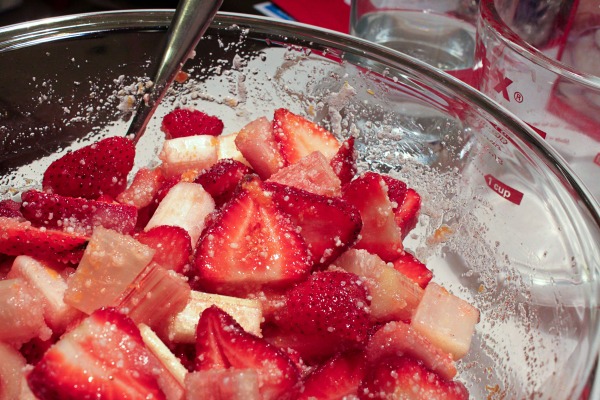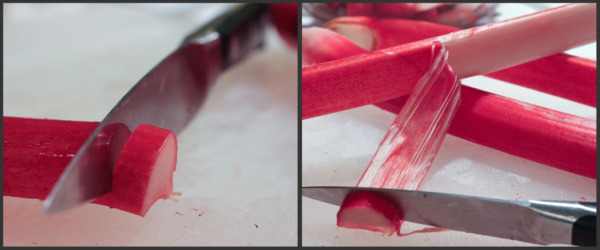Pho Bac
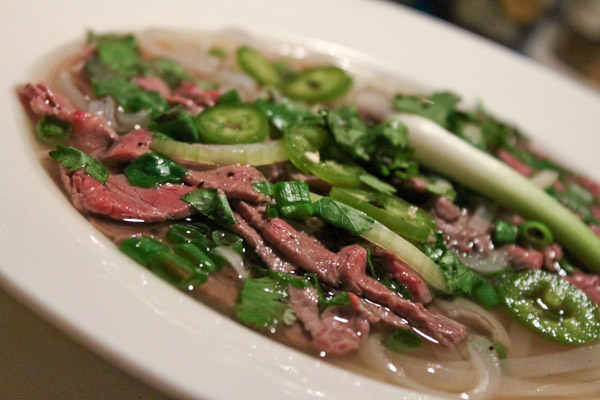 OMPG…that is, Oh My Pho-king God. This pho is really, really good! You know those meals that take a long time to make, but when you finally sit down to eat them you are overwhelmed by just how good they are and know that every minute was worth it? This is that meal.
OMPG…that is, Oh My Pho-king God. This pho is really, really good! You know those meals that take a long time to make, but when you finally sit down to eat them you are overwhelmed by just how good they are and know that every minute was worth it? This is that meal.
I’m taking Monday off from work, thus making this a three-day weekend. Although I am sticking around the city, I wanted to make it special and feel like a true holiday. What better way to do that than to re-visit one of my favorite countries–Vietnam. The summer before last I spent a couple months backpacking around India and southeast Asia, and Vietnam just felt so special to me. Actually, all the counties felt special but Vietnam was the perfect blend of everything I loved about my trip. It was also the first point of my trip that I was traveling solo, thus making it all the more special.
So yesterday I wanted to “re-visit” my experience. Unfortunately, in New York we don’t have large enough of a Vietnamese population to create a “little Vietnam,” but our Chinatown is quite impressive and sells a lot of food items that are staples throughout Asia. So I jumped on the subway and got off at Grand Street where I then entered into the closest experience we have to Asia. Like Vietnam, the markets were all bustling along the streets as hoards of people were scattered about buying their produce, fish, noodles, etc. English was certainly rarely spoken. This isn’t Vietnam of course, but feeling the energy of the place and smelling a lot of the familiar scents that I associate with Vietnamese markets just made me really happy. I hopped in amongst the masses of people and made my way around the markets grabbing everything I needed to make my pho.
Once home, I immediately started the long process knowing that I had about 4-5 hours ahead of me. This recipe calls for making the beef broth from scratch, which is the key to why this soup is so amazingly good and fresh tasting. The spices are also key to pho and are what make it unique from any other beef and noodle soup. An interesting combo of star anise, black cardamom, cinnamon and fennel seeds are infused into the soup adding a special depth to the flavor. Ginger and shallots are also thrown in, making the broth all the more richer and tastier. The process may take a while, but I found it soothing and relaxing. I sipped on wine as the broth simmered and infused my apartment with its rich fragrance, which lead me to reminiscing about my time in Vietnam.
Finally the pho was ready to eat. I sat down with my bowl and immediately dug in, at which point I was elated by just how good it was. More memories flooded in as I recalled times sitting out on the streets in cities and towns like Hanoi (where I first ate Pho), Hoi An and Dalat. I remembered walking around Hanoi’s food markets early one morning and observing all the locals eating pho at the street-side tables (in Vietnam, pho is actually a breakfast food). I also recalled one of my favorite experiences in Vietnam–riding a bike through the countryside outside Hoi An, where there was nothing but rice paddy fields and water buffalo around me. I also reminisced about my last night in Vietnam where I sat on the steps that overlook Dalat’s market square thinking about the amazingly special day I had meeting some darling schoolgirls and how sad I was to leave.
It’s so amazing to me how a meal can transform my experience to something more than just eating. If you’ve been to Vietnam or want to “visit,” you should certainly make this pho and soak in all of the aromas of this special place.
So here is the recipe slightly adapted from Andrea Nyugen’s in Saveur (yes I know all my recipes lately come from here, but it’s truly the best cooking magazine out there). In the original recipe, it has you slice up and add to your serving bowl the beef chuck that was used in making the broth. Although I appreciate not wasting this meat, I found it to be overly dry and tasteless since all the flavor had been transferred to the broth. Therefore, I’d recommend not using this for your serving and instead focusing on the fresh sirloin for the meat. Because of this, I increased the portion of sirloin. As for obtaining the ingredients, you should be able to find everything in the Asian section of your market. The dried scallops may be more difficult to find, but you can substitute it with a little MSG. This makes 8 servings. Even if you are only serving one, make the whole recipe for the broth portion (up through the fish sauce) and then freeze what’s left (see note at bottom).
- 4 large shallots, unpeeled
- 1 four inch piece ginger, unpeeled
- 1 tsp fennel seeds
- 5 star anise
- 1 three inch stick cinnamon
- 1 pod black cardamom, crushed
- 5 lbs. beef leg bones, cut into 2″–3″ pieces
- 1 1/2 lbs boneless beef chuck, trimmed and cut into 4″ x 2″ x 1 1/2″-thick pieces
- 1/2 oz dried scallops (the smallest ones are fine)
- 2 tbsp kosher salt, plus more
- 1/4 cup fish sauce
- 8 scallions, green parts thinly sliced, white parts left whole
- 1 1/2 tbsp unseasoned rice vinegar
- 2 serrano chiles, stemmed and thinly sliced crosswise
- 2 lbs. small flat rice noodles, similar in size to linguine
- 16 oz beef sirloin, cut across grain into 1/16″-thick slices (suggest to your butcher that he/she use the deli slicer). Cut into bite size strips.
- 1 medium yellow onion, thinly sliced, soaked in cold water for 30 minutes
- 1/3 cup cilantro leaves
- Freshly ground black pepper, to taste
- Place bones in a 12 quart stock pot. Cover with cold water by one inch and bring to a boil. Cook for 3 minutes, then drain and rinse the bones. Also rinse the pot out.
- Meanwhile, turn the broiler on in your oven. Arrange the shallots and ginger on a foil lined baking sheet and place 4 inches under the broiler. Flip shallots and ginger periodically until they are blackened (about 20 minutes). Let cool and then remove skins from each. Cut ginger in half lengthwise, then take the side of your knife and smash the two sides to flatten them. Set all aside.
- Over medium heat in a small skillet lightly toast the fennel seeds, star anise, cinnamon and black cardamom. This will take about 3 minutes. Pour out into a small bowl or plate and set aside.

- After the stock pot and bones have been drained and rinsed from Step 1, place bones back into pot. Add the reserved shallots and ginger, as well as, the beef chuck. Cover with 6 quarts of cold water and bring to a boil. Once boiling, reduce heat to medium low and add reserved toasted spices, dried scallops and 2 tbsp of salt. Let simmer for 1 1/2 hours, periodically skimming the surface.

- Remove the beef chuck and reserve for another use.
- Continue simmering the broth for another 1 1/2 hours.
- Discard the bones. Pour broth through a fine strainer lined with cheesecloth into a 6 quart pot. Skim any remaining fat. Place pot over low heat to keep broth hot.
- Add fish sauce and scallion whites to the broth.
- Mix serrano chiles in a small bowl with vinegar and set aside.
- Prepare the rice noodles per the packaging. Rinse in cold water and drain. Place noodles in each serving bowl.
- Top noodles with raw beef sirloin strips, onions, scallion greens and cilantro. Add ground pepper to taste.
- Ladle broth into the bowls over the noodles (the hot broth will cook the beef). Use white scallion pieces in the broth to garnish. Serve with serrano chiles on the side.
Cheers!
Note:
My friend’s mom once gave me an excellent suggestion for freezing soup. Once the soup has cooled, ladle individual servings into zip lock bags and then lay them flat in your freezer in stacks. As a result, they pack efficiently in your freezer and you can easily just grab the number of servings that you need at a given time. I also place wax or parchment paper in between the bags to help insure that they do not freeze together.
Marinated Sardines (Sardeles Ladolemono)
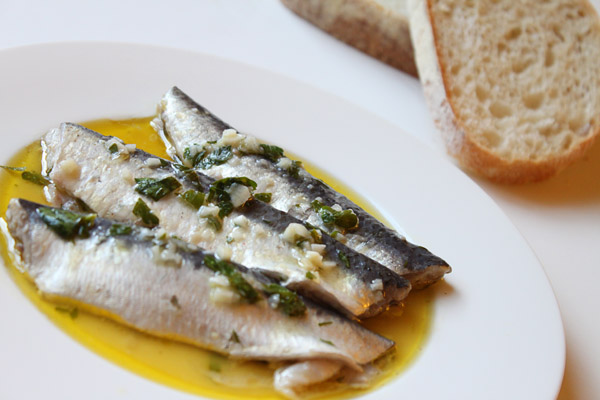 I remember the first time I ate marinated sardines. My friend, O’Hara, took me to one of her favorite restaurants in the Carroll Gardens section of Brooklyn. I don’t recall the name of the restaurant, but what I do recall is that we sat along a counter that overlooked the small kitchen where everything was cooked. As we sipped wine, we ordered various dishes including Bruschetta with marinated sardines. I was already feeling inspired by watching the chefs do their thing in the kitchen, but then also tasting the saltiness of the sardines on top of the rich, buttery crunch of the bread and with the lovely, fresh, garlicky taste of the marinade…well, I was in heaven. So when I saw this recipe for marinated sardines in my Saveur magazine, I was really excited to try it out.
I remember the first time I ate marinated sardines. My friend, O’Hara, took me to one of her favorite restaurants in the Carroll Gardens section of Brooklyn. I don’t recall the name of the restaurant, but what I do recall is that we sat along a counter that overlooked the small kitchen where everything was cooked. As we sipped wine, we ordered various dishes including Bruschetta with marinated sardines. I was already feeling inspired by watching the chefs do their thing in the kitchen, but then also tasting the saltiness of the sardines on top of the rich, buttery crunch of the bread and with the lovely, fresh, garlicky taste of the marinade…well, I was in heaven. So when I saw this recipe for marinated sardines in my Saveur magazine, I was really excited to try it out.
The key to this recipe is first starting off with good, fresh sardines–not the kind in the cans. I headed to my neighborhood fish market, where I found some beautiful sardines. I then had the fishmonger clean the fish for me (there is no need for you to have to deal with that mess if they can do it for you!). When I brought them home, I began the process for the recipe.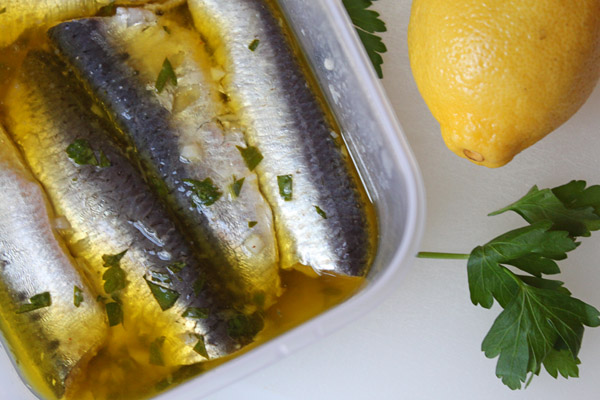
The first step involved me removing the spine from the fish. This was a bit more timely than I had expected. If you can get your fishmonger to do that for you as well, I recommend it. Otherwise, make sure you have a pairing knife with a good, pointed end. You will need that point to navigate the knife between the bones and meat. Once this process is done, it is all easy from there.
I had to wait patiently for a day to let the marinade do its thing. This works like a ceviche in that the acids in the lemon juice (and don’t you dare use anything but fresh lemon juice for this) cooks the fish. Meanwhile, the flavors in the olive oil and garlic weave themselves into the fish as well. Altogether, this makes for a really nice dish with lots of flavor.
So here is the recipe, adapted from Saveur magazine.
- 12 sardines , cleaned
- 12 tbsp white wine vinegar
- Salt, to taste
- 3/4 cup extra-virgin olive oil
- 1/3 cup fresh lemon juice
- 2 tbsp chopped flat-leaf parsley
- 2 cloves garlic, minced
- Pepper, to taste
- Cut off the heads and fins on “tail-ends” of the sardines. Then take a pairing knife and carefully remove the spines. As you complete each fish, rinse it first with water and then pour a tbsp of white wine vinegar into the body and massage it in. Drain and then sprinkle some salt into the cavity. Place the fillet in a small bowl. Repeat with the remaining sardines.
- In a separate bowl, mix the remaining ingredients.
- Drain the sardines and spread them flat in a 8″ x 8″ container (if you do not have a containers this size, note that it is better to go smaller than larger so that the marinade will cover the fish). Pour the marinade over the sardines and work it into the fish.
- Cover the container and refrigerate it overnight. Periodically, re-work the marinade into the fish and flip them over (a few times is enough).
- The sardines are ready once they look cooked (i.e., the meat should be opaque).
- Serve with bread.
Cheers!
Garlicky Lentil Salad (Salata Adas)
 My apartment, my cutting board, my skin….they all smell of garlic. Twelve cloves of minced garlic, to be exact. Now if you do not like garlic, then needless to say you might want to stop reading now. (I feel the need to now make a joke about vampires but will refrain.) For those of us who do love garlic, well please continue because I think this dish will not disappoint you. You too can have garlic oozing out your pores with just a few bites of this lentil salad.
My apartment, my cutting board, my skin….they all smell of garlic. Twelve cloves of minced garlic, to be exact. Now if you do not like garlic, then needless to say you might want to stop reading now. (I feel the need to now make a joke about vampires but will refrain.) For those of us who do love garlic, well please continue because I think this dish will not disappoint you. You too can have garlic oozing out your pores with just a few bites of this lentil salad.
I found this recipe in my favorite magazine, Saveur, which notes that this dish comes from Lebanon. I was attracted to it because of the garlic, but also I love the texture of lentils before they reach that smushy stage. The freshness of the lentils while swimming in a bath of olive oil and garlic with fresh lemon sounded too good to pass. Mix in some mint and parsley, it gets even better. And cumin with allspice? Now that’s interesting yet so clever.
It goes without saying that this salad is quite potent with garlic. Therefore, be mindful of that when pairing it up with other dishes. Saveur suggests that you serve it with lamb or grilled sausages, which I agree with. I think this could also be good as a garnish for a nice, white fish like tilapia. And if you are like me, you can even just have it as a meal in itself (assuming you are not seeing anyone for 24 hours).
So here is the recipe adapted from Saveur magazine (and originally created by Carolyn Forché). This serves 2-4 people.
- 1 cup green lentils, rinsed
- 8 tbsp extra-virgin olive oil
- 12 cloves garlic, minced
- 3 tbsp fresh lemon juice (anything that squeezes out of a plastic lemon is not fresh)
- 1 tsp ground cumin
- 1/4 tsp ground allspice
- 1 tbsp minced flat-leaf parsley
- 1 tbsp minced fresh mint
- Salt and pepper, to taste
- In a 2 quart pot, bring 3 cups of water and the lentils to a boil. Then turn the heat down and let simmer for about 30-35 minutes. Lentils are done when they are soft yet still maintain a firm body. Drain and set aside.
- In a 8 inch skillet over medium heat, add 2 tbsp of the olive oil and let heat up. Add the garlic and saute mixing frequently until the garlic is cooked (it will look translucent, about 7-8 minutes).
- Remove the skillet from the heat and add the remaining olive oil, lemon juice, cumin and allspice. Mix well.
- Pour the mixture over the lentils and mix.
- Before serving, toss in the parsley and mint, and season with salt (generously) and pepper, to taste. Serve at room temperature.
Cheers!
Roasted Five-Spice Chicken
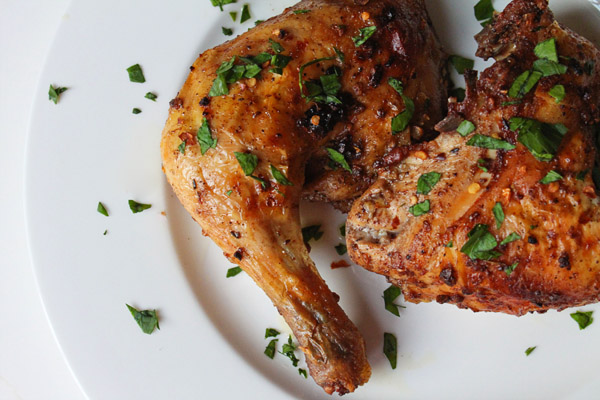 Sundays for me are not only a day to relax, sleep off a late night if needed, and catch up on my reading; but Sundays are also my favorite day of the week to cook. Mid-day I start thinking about what dish I’m in the mood for and then spend time looking up recipes for the perfect one. Once the recipe is picked, I then head over to the market where I take my time perusing the aisles and picking up the ingredients. Oh how I love food shopping when I have the time to wander around. Once my food shopping fix is satisfied, I then stroll back home. I ceremoniously put on my apron and then pull out a glass and poor some wine from the bottle that I’m trying to finish up at the moment. From there, I turn on some music and start the chopping, and well, you know how it goes on from there. This is my ideal Sunday.
Sundays for me are not only a day to relax, sleep off a late night if needed, and catch up on my reading; but Sundays are also my favorite day of the week to cook. Mid-day I start thinking about what dish I’m in the mood for and then spend time looking up recipes for the perfect one. Once the recipe is picked, I then head over to the market where I take my time perusing the aisles and picking up the ingredients. Oh how I love food shopping when I have the time to wander around. Once my food shopping fix is satisfied, I then stroll back home. I ceremoniously put on my apron and then pull out a glass and poor some wine from the bottle that I’m trying to finish up at the moment. From there, I turn on some music and start the chopping, and well, you know how it goes on from there. This is my ideal Sunday.
Despite my love for cooking on Sundays, for one reason or another I just haven’t been able to do it in a while. Whereas some people get antsy when they haven’t been to a gym in a while, I was feeling antsy from not having my Sunday afternoon cooking. I really needed my fix and made sure to rectify the situation this past weekend.
For my return to this ritual of mine, I wanted something that was comforting and that would fill my apartment with the smells of a good home-cooked meal. My instant first thought was roast chicken. How perfect. Not to mention how much I love having leftovers through the rest of the week. I began my search for a recipe. Saveur‘s website lead me to a recipe for a roasted five-spice chicken posted on The Hungry Mouse‘s food blog. How perfect! Just the comfort food I was looking for, but with a little twist of spice.
 I believe this recipe is an original one created by The Hungry Mouse, and it is fantastic. Not to mention quite easy–in fact, almost too easy for my Sunday afternoon to be honest. You start by making a marinade that smells (and tastes) amazing. How can you go wrong with anything that involves sesame oil, fresh garlic and five-spice seasoning (see note below about five-spice powder)? I let my chicken marinade in this for about 5 hours, but the blog suggests that if needed you can go ahead and cook the chicken right after covering it in the marinade. From there you then just pop the chicken in the oven, and voila, about 50 minutes later you have tasty roast chicken.
I believe this recipe is an original one created by The Hungry Mouse, and it is fantastic. Not to mention quite easy–in fact, almost too easy for my Sunday afternoon to be honest. You start by making a marinade that smells (and tastes) amazing. How can you go wrong with anything that involves sesame oil, fresh garlic and five-spice seasoning (see note below about five-spice powder)? I let my chicken marinade in this for about 5 hours, but the blog suggests that if needed you can go ahead and cook the chicken right after covering it in the marinade. From there you then just pop the chicken in the oven, and voila, about 50 minutes later you have tasty roast chicken.
The Hungry Mouse‘s recipe calls for 6 chicken leg quarters, or about 4.5 – 5 pounds. Knowing that was too much for me, I instead made it with a quartered chicken (2 breasts, 2 legs/thighs) that amounted to 3 pounds. I found that the marinade just covered what I had without any extra hanging out. This made me think that if I had made the recipe with 4.5 – 5 pounds of chicken, then I would have wanted more marinade. Something for you to think about. I mean you don’t want to miss out on all the good flavor, do you? Lastly, I also had a couple chicken wings that I threw in. They were really, really good–like probably my favorite part. If you are looking for a chicken wing dish for football or some other social gathering, this would also be a great marinade for that as well.
Okay, here is the recipe. The original recipe can be found here. Below I have all the same ingredients and measurements, but I just consolidated the directions. I do recommend also referring to The Hungry Mouse‘s post, which includes really nice step-by-step photos. Again, as a reminder, you may want to consider increasing the marinade measurements by 1.5 or 2 times. This serves 4-6 people.
- 4 garlic cloves, minced
- 1 tbsp kosher salt
- 2 tbsp toasted sesame oil
- 1 tsp Chinese five-spice powder (see note)
- 1 tbsp rice wine vinegar
- 6 chicken leg quarters, 4 1/2 – 5 lbs.
- chili flakes, for garnish
- minced parsley and/or sliced scallion, for garnish
- Set the oven to 425 degrees.
- In a bowl mix the garlic, salt, sesame oil, five-spice powder and rice vinegar.
- Mix the marinade with the chicken and let sit for a few minutes or up to a day (remember to refrigerate the chicken as it marinades!). I prefer doing this in a zip lock bag, but a covered bowl also works.
- Lay the chicken pieces on a baking sheet (covered with tin foil if you want easier clean-up), spread apart. Keep the skin sides up.
- Place the chicken in the oven and let bake for about 50 minutes. Keep an eye on the chicken and if the garlic starts to burn, you can then lightly cover the chicken with tin foil. The chicken is ready once the juices run clear and the internal temperature reaches 165 degrees.
- Once ready, remove the chicken from the oven and let sit for about 10 minutes.
- Serve, sprinkled with red chili flakes and parsley/scallions.
Notes
What is five-spice powder? This is a very favorable Chinese seasoning that mixes ground star anise, cloves, cinnamon, pepper and fennel seeds. It is easily found in grocery stores along with all the other seasonings. At my market, it was labeled “Chinese Five-Spice” so was under the “C’s” in lieu of the “F’s”, where I first searched.
Cheers!
Linguine with Clam Sauce
 Lately I have been on a huge seafood kick. Salmon baked with soy sauce and ginger for dinner Sunday night, Monday’s lunch was octopus salad and later in the day for dinner was linguine with clams, and today’s lunch was at Mary’s Fish Camp where I had grilled calamari on a bed of greens with cilantro, lime and mint followed with a bowl of cockles with white beans and garlic. I’m loving it and can’t get enough at the moment!
Lately I have been on a huge seafood kick. Salmon baked with soy sauce and ginger for dinner Sunday night, Monday’s lunch was octopus salad and later in the day for dinner was linguine with clams, and today’s lunch was at Mary’s Fish Camp where I had grilled calamari on a bed of greens with cilantro, lime and mint followed with a bowl of cockles with white beans and garlic. I’m loving it and can’t get enough at the moment!
Most of these dishes I ate out at restaurants; however, I did make the linguine with clams for a couple friends I had over for dinner last night. I wanted to make something special, but I also wasn’t in the mood for a stressful evening of cooking either. I was thrilled when I came across this recipe on Cooking Light’s website. I had actually never cooked with clams before so I was really excited to try this out, and even more excited to see just how easy this was.
I made some adjustments to the recipe. I added some more garlic, more clam juice, and added butter. Probably some more olive oil too, though I never measured it to really say for sure. Overall, I loved this. My only regret was that I used fresh fettuccine in lieu of linguine. My thought was that the fresh pasta would be ideal (my market didn’t have fresh linguine as a choice), and maybe it would have been, but not in fettuccine form–it was just too thick and heavy for the dish. So be sure to use linguine. If you have spaghetti, that should work too. Oh, also, I’ve heard rumors that there are people out there who use canned clams for this dish. Really? Please do try to avoid this. I mean, just having the cute, little shells in your bowl make it worth it, right?
So here is the recipe, adapted from Cooking Light. This officially makes 6 servings, but I’d say it’s really about 4 meaningful servings (this is Cooking Light after all).
- 1/4 cup olive oil, divided
- 3 garlic cloves, chopped
- 1/2 cup clam juice
- 3/4 teaspoon crushed red pepper
- 1/2 teaspoon salt
- 1/4 teaspoon freshly ground black pepper
- 3 dozen littleneck clams
- 1/4 cup chopped fresh flat-leaf parsley
- 1 pound uncooked pasta
- 3 tbsp butter, cut into 3 pieces
- Rinse clams, making sure any grit on them has been removed.
- Add the pasta to salted, boiling water and prepare per the package directions.
- In a large skillet (with a lid and large enough to eventually hold all the clams) over medium heat saute the garlic in about 2 tbsp of olive oil for a couple minutes. Make sure that you do not burn the garlic.
- Add the clam juice, crushed red pepper, salt, black pepper, clams, and parsley. Cover and cook for about 10 minutes, or until the clams open.
- Meanwhile, when the pasta is ready drain it and mix it with the remaining olive oil (2 tbsp) and butter.
- Add the clams and sauce to the pasta, toss and serve. Season with additional salt and pepper, if needed.
Cheers!
Summertime Adventures
Yes, I am still here but summertime brings with it lots of activities to keep this foodie busy. A highlight was spending a long weekend in Newport, RI. It was my first time there, and I loved it–a definite must for anyone within reach of the island.
If you find yourself in Newport, I recommend that you eat at Scales and Shells. As the name suggests, this is a seafood restaurant that serves incredibly fresh fish in a no-nonsense setting. I had mussels to start, which were in a garlic broth that was a meal in itself soaked into bread. I followed that with grilled lobster, which was also such a treat since lobster in New York tends to exceed my budget. To further take advantage of eating as much lobster as possible, another day we headed down to Newport’s Aquidneck Lobster Co. This is essentially a warehouse of lobster and other seafood that you can buy by the pound. My friends and I picked-up an assortment of lobsters, clams, salmon, and swordfish here and spent an evening cooking up this feast. It was super affordable (the lobsters were about $7/pound) and a really nice way to spend an evening with friends. To learn more about our trip and other ideas for Newport, you can go here at The New York Escapist.
Another summertime adventure was a photography class that I took. The two month course ended with an exhibition of our work–basically a slight upgrade from hanging our work on mom’s refrigerator. We chose a subject to focus our work on, and of course the foodie that I am had to choose something food related. So coffee was my subject. Needless to say, I spent several weekend afternoons completely high and shaking off of caffeine overloads as I went from cafe to cafe.  I also had the treat of seeing a close friend of mine who lives in Boston. She recently came back from a trip that included hiking around the mountains in Peru. With coffee on my mind from my photography class, I was especially fascinated to see her pictures of coffee beans—as in the beans right off the plant. She was kind enough to let me share them with you. Did you know that coffee beans are actually creamy white in their raw form?
I also had the treat of seeing a close friend of mine who lives in Boston. She recently came back from a trip that included hiking around the mountains in Peru. With coffee on my mind from my photography class, I was especially fascinated to see her pictures of coffee beans—as in the beans right off the plant. She was kind enough to let me share them with you. Did you know that coffee beans are actually creamy white in their raw form?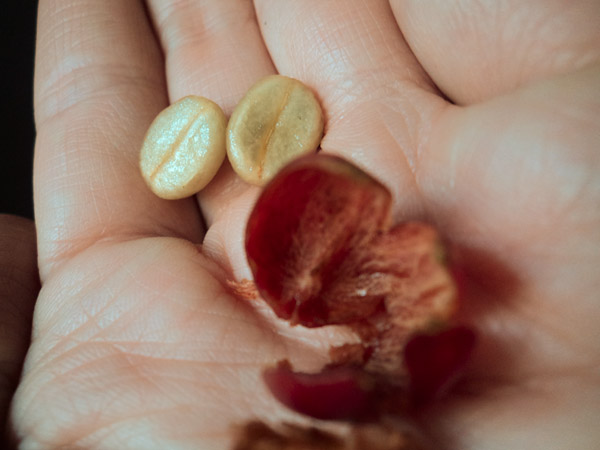
In the mountains of Peru the beans are picked out of their pods and, then they are laid out to dry on blankets in the sun. After the beans are dried through, they are gathered and placed in a heavy cast iron skillet. Next, the skillet is set over an open fire to start the roasting process.
After the beans are dried through, they are gathered and placed in a heavy cast iron skillet. Next, the skillet is set over an open fire to start the roasting process.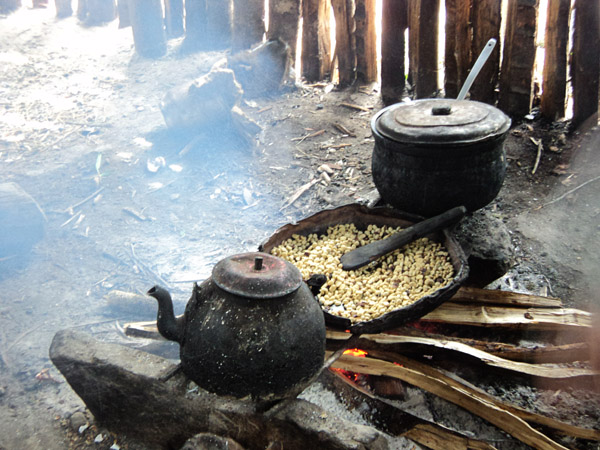 The beans are roasted over the fire until they reach a deep, rich brown. This roasting process enriches the flavor, and the beans are now ready to be ground and made into coffee.
The beans are roasted over the fire until they reach a deep, rich brown. This roasting process enriches the flavor, and the beans are now ready to be ground and made into coffee. Isn’t that so fascinating? I know that there are some coffee roasters nearby New York in the Hudson River Valley, so I am now hoping to make a visit and learn more!
Isn’t that so fascinating? I know that there are some coffee roasters nearby New York in the Hudson River Valley, so I am now hoping to make a visit and learn more!
Meanwhile back in New York, my friend Sonya and I hosted a dinner party at her beautiful apartment. I loved being able to cook in a spacious kitchen and serve dinner at an actual dining room table that comfortably sat our eight guests (at my place, dinner parties mean my friends kindly sit on the floor around the coffee table). We served a yummy Lemon and Rosemary Chicken dish that I think is a must for your next dinner party. It was super tasty and quite easy. You can find the recipe for it here from Saveur Magazine.
Now I am off to pick up the ingredients to make Watermelon-Mint Popsicles. Summertime may be almost over, but that doesn’t mean I can’t still make the most of it!
Cheers
Sunchokes with Walnuts and Orange Zest
Summer is here, my friends! So are lots of summer plans to fill up our evenings making it harder to find the time to cook at home. Or at least that is what I am finding. Not to mention wanting to be healthy so that I don’t completely embarrass myself at the beach. Oh, and isn’t it just too hot to turn on the oven or even the stove? My window AC unit just can’t handle the heat as it is! So what’s a girl to do?
Well, for a while now—two months to be exact—I’ve been carrying around a recipe that I tore out of my New York magazine. Every issue features an item in the food section that is in season at the local farmers’ markets, and this particular issue featured sunchokes (also known as Jerusalem artichokes). I’ve seen this interesting looking root vegetable before but never knew what to do with it. In fact, once I picked some up at the farmers’ market only for them to go bad before I figured out a recipe for them. Not this time. I had already wasted too many sunchokes’ lives, and it was time for me to step up to the plate (no puns intended).
 So this afternoon as I reach into my purse for something, I was quite pleased to see the worn out page with the recipe. What a perfect time to finally make this salad. It’s easy. It’s healthy. It doesn’t require any heat. At last!
So this afternoon as I reach into my purse for something, I was quite pleased to see the worn out page with the recipe. What a perfect time to finally make this salad. It’s easy. It’s healthy. It doesn’t require any heat. At last!
This particular recipe comes from Mario Batali, hence the creatively clever use of ingredients (he might be a celebrity chef, but I’m a fan). The orange zest is such a nice twist, adding freshness with some zing. The walnuts add a nice crunch. The garlic rounds out the flavor. The recipe calls for toasting the walnuts, and I definitely recommend that you do this. I skipped that step (I was pretty determined to not turn on a stove or oven) but wish I hadn’t because that would have concentrated the nuttiness and enhanced the nutty flavor of the sunchokes. I also think adding a little bit a crumbled feta cheese would make this dish that much better. Just a thought, Mario.
 I also want to note that this recipe calls for thinly shaving the sunchokes, which is important. If the slices are too thick, it will make for a less appetizing, heavy salad. You will need a mandoline or vegetable slicer to shave them. If you have none of these items but desperately still want to make the salad, I suggest cutting the slices crosswise into sticks to “lighten” them.
I also want to note that this recipe calls for thinly shaving the sunchokes, which is important. If the slices are too thick, it will make for a less appetizing, heavy salad. You will need a mandoline or vegetable slicer to shave them. If you have none of these items but desperately still want to make the salad, I suggest cutting the slices crosswise into sticks to “lighten” them.
By the way, if you are wondering, “Um, Kristin, what the heck does a sunchoke even taste like?” let me answer that. Uncooked, it’s texture and density is similar to that of other raw root vegetables, like potatoes but slightly smoother. Also the flavor is mellow with a raw nuttiness, making it a great starting component to a dish.
Shall we move onto the recipe now? Here you go folks:
- 1 lb firm sunchokes, scrubbed clean
- 2 tbsp extra-virgin olive oil
- 1/3 cup fresh Italian parsley, coarsely chopped
- 1/4 cup walnuts, toasted and finely chopped
- 2 tbsp slivered orange zest
- 2 garlic cloves, finely chopped
- 1/3 cup crumbled feta cheese (optional)
- Flaky sea salt or Kosher salt, to taste
- Ground black pepper, to taste
- Thinly shave the sunchokes with a mandoline, vegetable slicer, or food processor (if you have a thin slicer attachment).
- Add the shaved sunchokes to a large bowl and toss thoroughly with olive oil.
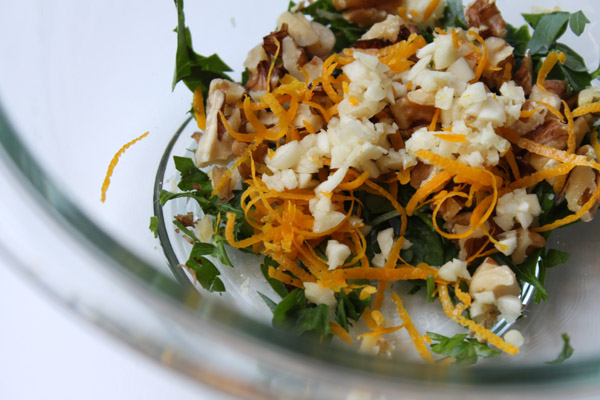
- Mix in the parsley, walnuts, orange zest, garlic and optional feta.
- Add salt and pepper to taste.
Cheers!
Follow me on Twitter at “thepearlonion”!
Prejean’s Famous Gumbo
 Last weekend I headed down to New Orleans to see my parents who live there and to soak in some much needed southern time. This involves feeling the warm air with a slight edge of humidity this time of year, smelling the Cajun seasonings in a restaurant while drinking an Abita beer, watching the enormous barges get pushed up the Mississippi river by their little tugboat, seeing the performers in the French Quarter entertain the crowds, and getting powder sugar from Café Du Monde’s beignets all over my clothes. It was all divine and just what I needed.
Last weekend I headed down to New Orleans to see my parents who live there and to soak in some much needed southern time. This involves feeling the warm air with a slight edge of humidity this time of year, smelling the Cajun seasonings in a restaurant while drinking an Abita beer, watching the enormous barges get pushed up the Mississippi river by their little tugboat, seeing the performers in the French Quarter entertain the crowds, and getting powder sugar from Café Du Monde’s beignets all over my clothes. It was all divine and just what I needed.
Once a week my parents take a little field trip exploring the areas outside the city. Sometimes they head up the Mississippi river to see all the old plantation homes and other times they might find their way to a far away restaurant they read about, but one of their favorite trips is to Avery Island in Louisiana’s famous bayou country. Although this island may be more commonly known as the home of the popular Tabasco sauce, it is also the home of Jungle Gardens—a remarkably gorgeous park filled with Spanish moss covered trees, swamps, egrets, and alligators.
For me, the alligators were the most fun to see. Before I let you think I am overly courageous, I should admit that the alligators in this park are all under five feet long. Anything larger gets moved to less visited swamps in the area. Nonetheless, it was exciting—if not a little scary—walking up to see the alligators close-up. I mean, I was at least a little courageous, right?
Once we left Avery Island we then headed to Lafayette, passing by fields of sugar cane and small little towns. I even saw one man sitting on his front porch playing his saxophone as the farmers were beginning to end their day. I love seeing the countryside in Louisiana—it is still so rich in culture. Time here just seems to pass by more slowly and take me back to an earlier era.
Our destination in Lafayette was Prejean’s, who are famous for their pheasant, quail and andouille gumbo served at New Orleans’ Jazz Fest. My brother and his wife discovered this heavenly gumbo, and as a result my parents have now made Prejean’s one of their favorite stops on field trips in the area. My dad excitably told me about their dinners there where Cajun bands play at night and diners step up from their tables to dance along the music. It sounds just like how I romanticize the social scenes in these small towns out in the country.
Since we had other dinner plans, we were not dining in but picking up a gallon of their pheasant, quail and andouille gumbo to take home for a later night. When the lady first brought out the gumbo, I immediately noticed how rich in color it was. If the color was any indication of the richness in taste, then I knew this was going to be special and I was looking forward to trying it.
Finally on my last night in New Orleans, we had the gumbo and it was incredibly abundant in flavor. The gaminess of the pheasant and quail mixed with the richly flavored broth was the perfect match. Then coupled with the spiciness of the andouille sausage…well, that was just pure perfection.
A few days after I was back in New York, missing my time in New Orleans, my dad sent me the recipe for Prejean’s gumbo that he had found at Nola.com. I could hardly wait for the weekend to roll around so that I could make this.
Now, the recipe calls for some ingredients that may be hard to find. I don’t know about y’all, but I just don’t get to do much pheasant hunting in Central Park. As a result, I had to make some substitutions. I replaced the pheasant and quail with chicken thighs (you want dark meat that will more closely match the flavor of pheasant). Duck meat would be an even better substitute, if you can find it. I was unable to find Cajun smoked sausage, so I just added more andouille sausage instead. Lastly, I was actually able to find Kitchen Bouquet (a browning and seasoning sauce found in the gravy products section at the market), but if you are unable to you can substitute this with worcestershire sauce.
I also want to discuss the dark roux with you. This is the most important part of gumbo; and without a good, dark roux you just don’t have gumbo. The dark roux gives the gumbo it’s color and rich flavor. To achieve it, you must be patient—cooking it slowly over low heat and mixing constantly. Once it reaches a deep, reddish brown color, it is ready. Go here to see the progression of colors. After you remove it from the heat it will then continue to darken to a rich brown the color of dark chocolate. Be sure to taste it to ensure that it is not bitter or burned. If it is, well, it’s back to the stove you go to make a new batch.
So here is the adapted recipe, using my substitutes to make it more user friendly (for the original recipe, you can find it here). I also halved the recipe, but for a family you may want to double it back since this does take time to make and it would be nice to have for another meal. Note that this tastes even better if you let it sit overnight refrigerated. The recipe below makes 2.5 quarts.
- 2 ½ tbsp butter
- 2 ½ tbsp flour
- 2 tbsp corn oil
- 6 oz andouille sausage, sliced into ¼ inch thick circles
- 1/3 cup coarsely diced onion
- ¼ cup coarsely diced bell pepper
- 2 tbsp finely diced celery
- 4 chicken thighs, skin removed (or 2 large skinless duck breasts)
- 1 tbsp paprika
- ¼ tsp black pepper
- ¼ tsp cayenne pepper
- 1 small bay leaf
- 1 ¼ quarts concentrated chicken stock (you can start with 1 ¾ quarts and boil it down to 1 ¼ quarts to make it concentrated, or add a bouillon cube)
- 1 tsp Kitchen Bouquet (or worchestershire sauce)
- 2 dashes Tabasco
- 1 ½ tbsp sliced green onion tops
- In a small skillet over medium low heat, add the butter and flour. Stir constantly and thoroughly as color slowly depends in color and reaches a dark, reddish brown. This process should take at the very least 20 minutes (mine took 40 minutes). Remove from heat and pour into a container. Set aside. The color will continue to deepen to a dark, chocolate brown. (Tidbit: You can make larger portions and freeze what you don’t need as a short cut for your next gumbo.)
- Heat corn oil to hot and maintain heat in a four-quart cast-iron or other heavy pot over medium-low heat.
- Meanwhile, in a nonstick skillet over medium heat, brown andouille sausage, then add to oil in the cast-iron pot. Repeat process with onion, bell pepper and celery, then chicken (or duck), sautéing each ingredient individually and transferring each ingredient to the cast-iron pot as it is browned.

- Add the paprika, black pepper, cayenne and bay leaf to the pot and stir. Mix in stock. Stir in roux until blended.
- Bring to a boil and cook 40 minutes, stirring attentively.
- Add Kitchen Bouquet (or worchestershire sauce), Tabasco and green onions and stir well. Simmer 5 minutes longer.

- Pull out chicken (or duck) and with tongs and a fork (the meat will be too hot to handle with your fingers), shred the meat and add it back to the gumbo and mix.
- Serve hot alone or with white rice.
Cheers!
Old Bay Steamed Shrimp
 Now that the weather is finally warming up, all I can think about is seafood. I’m craving it immensely. I’m thinking about boiled crawfish and po’ boys in New Orleans, peel and eat shrimp at the beach, oysters at a martini bar, lobster rolls from Maine…well, you get the idea.
Now that the weather is finally warming up, all I can think about is seafood. I’m craving it immensely. I’m thinking about boiled crawfish and po’ boys in New Orleans, peel and eat shrimp at the beach, oysters at a martini bar, lobster rolls from Maine…well, you get the idea.
Last weekend I was particularly longing for peel and eat shrimp, which reminds me of trips to Destin, FL on the Gulf of Mexico growing up. This time of year takes me back to when I was in school in the years of yonder down in Alabama. I recall knowing at this time that only weeks separated me from the inevitable beach trip to mark the start of summer. The last day of school always had cars waiting outside filled with beach gear ready to head strait down. I also loved that most everyone went to the same beach, so it was hard to not run into friends from home—especially when you headed to my favorite beach restaurant, The Back Porch, in Destin. Everyone flocked here for the awesome seafood and fun atmosphere.
One of my favorite dishes to get at the beach restaurants like The Back Porch is peel and eat shrimp. As I perused The Lobster Place in Chelsea Market, I spotted some fresh shrimp brought strait up from the Gulf of Mexico. Well, I’ll be damned—it was meant to be! So of course I ordered up some of those shrimp, but now what? I hadn’t made peel and eat shrimp before so I walked around the store to see if they had Zatarain’s Shrimp and Crab Boil seasoning (a New Orleans staple). No such luck. I then spotted Old Bay Seasoning, which screams summer to me. Mmm…this could take me somewhere. Sure enough, they had a simple recipe on the container for steaming shrimp. Again, it was meant to be.
One of the things I particularly like about this recipe is just how quick it is to make. I can have this entire meal made in 10 minutes from start to finish. Not to mention, I love the Old Bay seasoned sauce that the dish ends with. I poured some into my bowl just to make sure the shrimp could hold as much as possible with each bite. With a nice glass of dry white wine, this makes the perfect summer meal.
So here you go. You can of course also find this recipe on the Old Bay Seasoning container. This makes enough for 2 servings.
- 2 tbsp Old Bay Seasoning
- 1/2 cup vinegar
- 1/2 cup water
- 1-2 bay leaves (my own addition)
- 1 lb shrimp, in shells
- In saucepan, combine first three ingredients and bring to a boil.
- Add the shrimp and stir gently.
- Cover and steam until tender, about 3-5 minutes. (Make sure you do not overcook the shrimp or they will get tough.)
- Serve, pouring some of the sauce over the shrimp if you desire.
Cheers!













